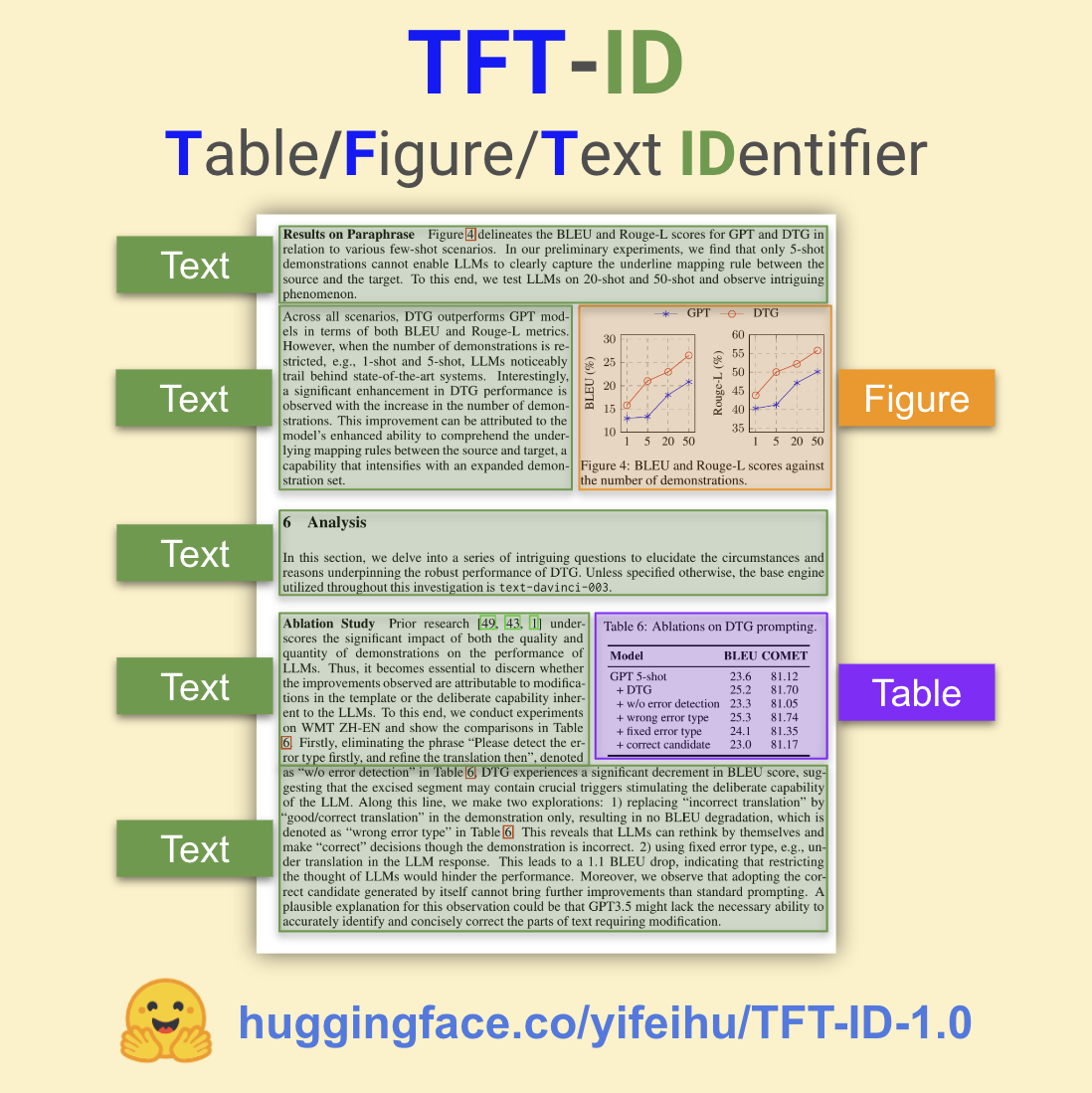🚀 TFT-ID: Table/Figure/Text IDentifier for academic papers
TFT-ID is an object detection model designed to extract tables, figures, and text sections from academic papers. It offers accurate identification and can be integrated with OCR workflows for text extraction.
🚀 Quick Start
Use the following code to start using the TFT-ID model. For non-CUDA environments, refer to this post for a simple patch.
import requests
from PIL import Image
from transformers import AutoProcessor, AutoModelForCausalLM
model = AutoModelForCausalLM.from_pretrained("yifeihu/TFT-ID-1.0", trust_remote_code=True)
processor = AutoProcessor.from_pretrained("yifeihu/TFT-ID-1.0", trust_remote_code=True)
prompt = "<OD>"
url = "https://huggingface.co/yifeihu/TF-ID-base/resolve/main/arxiv_2305_10853_5.png?download=true"
image = Image.open(requests.get(url, stream=True).raw)
inputs = processor(text=prompt, images=image, return_tensors="pt")
generated_ids = model.generate(
input_ids=inputs["input_ids"],
pixel_values=inputs["pixel_values"],
max_new_tokens=1024,
do_sample=False,
num_beams=3
)
generated_text = processor.batch_decode(generated_ids, skip_special_tokens=False)[0]
parsed_answer = processor.post_process_generation(generated_text, task="<OD>", image_size=(image.width, image.height))
print(parsed_answer)
To visualize the results, check this tutorial notebook for more details.
✨ Features
- Object Detection: Extract tables, figures, and text sections from academic paper images.
- Manual Annotation: All 36,000+ bounding boxes are manually annotated and checked.
- OCR Compatibility: The text sections are suitable for downstream OCR workflows.
📚 Documentation
Model Summary
TFT-ID (Table/Figure/Text IDentifier) is an object detection model finetuned to extract tables, figures, and text sections in academic papers created by Yifei Hu.

TFT-ID is finetuned from microsoft/Florence-2 checkpoints.
- The model was finetuned with papers from Hugging Face Daily Papers. All 36,000+ bounding boxes are manually annotated and checked by Yifei Hu.
- TFT-ID model takes an image of a single paper page as the input, and return bounding boxes for all tables, figures, and text sections in the given page.
- The text sections contain clean text content perfect for downstream OCR workflows. I recommend using TB-OCR-preview-0.1 [HF] as the OCR model to convert the text sections into clean markdown and math latex output.
Object Detection results format:
{'<OD>': {'bboxes': [[x1, y1, x2, y2], ...],
'labels': ['label1', 'label2', ...]} }
Training Code and Dataset
Benchmarks
The model was tested on paper pages outside the training dataset. The papers are a subset of huggingface daily paper.
Correct output - the model draws correct bounding boxes for every table/figure/text section in the given page and does not missing any content.
Task 1: Table, Figure, and Text Section Identification
| Model |
Total Images |
Correct Output |
Success Rate |
| TFT-ID-1.0[HF] |
373 |
361 |
96.78% |
Task 2: Table and Figure Identification
| Model |
Total Images |
Correct Output |
Success Rate |
| TFT-ID-1.0[HF] |
258 |
255 |
98.84% |
| TF-ID-large[HF] |
258 |
253 |
98.06% |
Note: Depending on the use cases, some "incorrect" output could be totally usable. For example, the model draw two bounding boxes for one figure with two child components.
BibTex and citation info
@misc{TF-ID,
author = {Yifei Hu},
title = {TF-ID: Table/Figure IDentifier for academic papers},
year = {2024},
publisher = {GitHub},
journal = {GitHub repository},
howpublished = {\url{https://github.com/ai8hyf/TF-ID}},
}
📄 License
This project is licensed under the MIT License.

